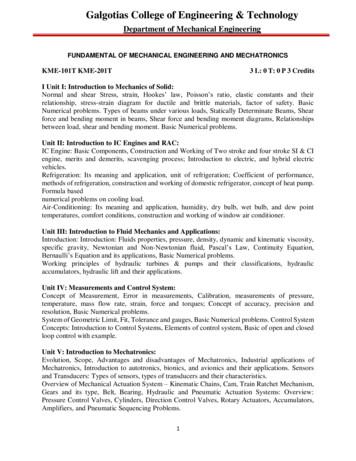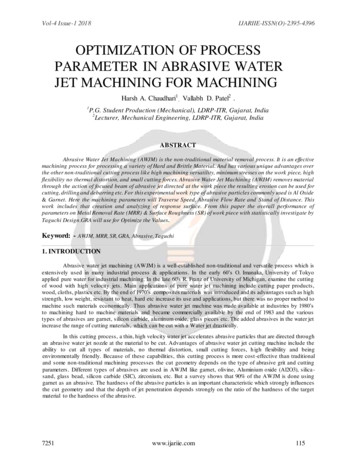Mechatronics - Mechanical Engineering
i-ChihWang
What is Mechatronics?Mechatronics is the integration ofmechanical, electrical, and computertechnologies into the design ofcomplex products
What is Mechatronics?Mechatronics is the integration ofmechanical, electrical, and computertechnologies into the design ofcomplex productsIllustrate with an exampleMagnetic Resonance ForceMicroscopyBy: Prof. Joe Garbini
Magnetic Resonance Force MicroscopyGoal: Image the 3D atomic structureof individual molecules First conceived at UW 15 years of effort ME involved from the start Now 20 research groupsinternationally
Challenge:- Detection of exquisitely small forces(Zepto-newtons, Zepto 10-21).- Operates near the quantum limit.- Subject to spin decoherence.- Image reconstruction.
Challenge:- Detection of exquisitely small forces (Zepto-newtons!).- Operates near the quantum limit.- Subject to spin decoherence.- Image reconstruction.MRFM funding: NSF, NIH, ARO, DARPA, IBM (Almaden).Primary- MURI (ARO), 1M per year, for 5 years (75% UW)Current funding:Goal:- Single nucleon detection.Collaborators: - Cornell: Prof. John Marohn- U Michigan: Prof. Al Hero- IBM: Dr. Dan Rugar- UW - School of Medicine: Prof. John Sidles- Mathematics: Prof. Ann GreenbaumPedagogic Goal: Quantum Systems Engineering.
Research IssuesMechanical Issues:Electrical Issues:Computational issues:Position and Thermal Control, VibrationsSignal ConditioningData acquisition and controller implementation
What is Mechatronics?Mechanical Issues:Electrical Issues:Computational issues:Position and Thermal Control, Vibrations,Signal Conditioning,Data acquisition and controller implementationMechatronics is the integration ofmechanical, electrical, andcomputer technologies into thedesign of complex products
What is Mechatronics?Mechanical Issues:Electrical Issues:Computational issues:Position and Thermal Control, Vibrations,Signal Conditioning,Data acquisition and controller implementationMechatronics is the integration ofmechanical, electrical, and computertechnologies into the design ofcomplex productsMechatronics builds on Core-ME-competencyin Dynamics, Vibrations, Controls, NonlinearSystems and Robotics
What drives Research inMechatronics?The need to improve performance
What drives Research inMechatronics?Need to improve performanceTwo ExamplesExample 1: by Prof. Steve ShenImprove Performance ofComputer Hard Drives
Vibrations in Spindle Motors of Computer Hard Disk DrivesProfessor I. Y. (Steve) Shen, ME DeptComputer Hard Disk DrivesFluid Bearing SpindlesMagnetClampSpacerRadial HDBSleeveDiskBase PlateMotorShaftThrust HDBNeed to Improve Performance(a) Increase Information density (Small bits)(Approach: increase the number of tracks)(b) Reduce data-access speed (High Speed)(Approach: increase spin speed)Problem: Small vibrations in the disc causeread/write errorSolution: New Technology : Spindle motors withfluid-dynamic bearingsResearch Issues: Integration of two fields – fluidsand nonlinear vibrations1.No mathematical models are available fordesign and optimization of disks/spindle.2.Design is done by trial and error;long and expensive design cycles.3.Almost no knowledge base is available.Prof. Shen has a Strong History of Collaborationwith Disk Drive Industry andLeadership Role in this Research Area
What drives Research inMechatronics?Need to improve performanceSecond Exampleby Prof. Martin BergImprove Performance ofLarge Robots
Adaptive End-Effector Position Control Performance ImprovementObjective:Order-of-magnitude improvement inthe accuracy to which the position ofthe end-effector of an industrialrobot/machine tool can be controlled. Research Issue:Interface of different scalesLarge scale --- large range of robotSmall scale --- need for precisionpositioning Started with Local CollaborationBoeing: Robot is shown in photo Funding:NSF funding to UW : 93K/yearPeriod: September 2004-August 2007Martin Berg
Recap: What drives Researchin Mechatronics Need to improve performance Interface of different scales – large range (largescale) robot with fine precision (small scale) Interface of different fields – fluids and vibrations inthe fluid-dynamic bearings
What are New Opportunities inMechatronics? Need to improve performance Interface of different scales – large range (largescale) robot with fine precision (small scale) Interface of different fields – fluids and vibrations inthe fluid-dynamic bearings
What are New Opportunities inMechatronics? Need to improve performance Interface of different scales – large range (largescale) robot with fine precision (small scale) Interface of different fields – fluids and vibrations inthe fluid-dynamic bearingsNew Scales:(a) Nano
What are New Opportunities inMechatronics? Need to improve performance Interface of different scales – large range (largescale) robot with fine precision (small scale) Interface of different fields – fluids and vibrations inthe fluid-dynamic bearingsNew Scales:(a) NanoNew Fields (Emerging applications)(b) Bio
What do we want to do?New Scales:(a) NanoNew Fields (Emerging applications)(b) Bio
What we want to do?We want to Leverage CoreCompetency when developing NewOpportunitiesCurrent expertise insub-nano scale positioning, control,Modeling and fabrication.Robotics, InstrumentationNew Scales:(a) NanoNew Fields (Emerging applications)(b) Bio
Faculty are already exploiting newopportunities in Bio/NanoPing AoModeling biological networksBio-medicalMartin BergAutomation for CrystallographyBio-medicalDistributed SystemsSantosh Devasiaa) AFM Imaging of human cellsb) Nanowire-Cilia-based PumpsNano/Bio-imagingBio-fluidicsJoe GarbiniImaging of molecular structuresub-nanoBio-moleculesPer ReinhallBiomedical sensors, Heat ValvesBio-medicalEric SeibelSingle-fiber endoscopeBio-medicalWei-Chih WangInstrumented Prosthetic FootwearBio-medicalBrian FabienModel Identification for ProstheticsBio-medicalDuane StortiNonlinear oscillations in Bio-systemsBio-mimetic Design
Detailed Example 1/3Automated Screeningof Protein CrystalsBy Martin Berg
Automated Annealing, Healing andScreening of Protein Crystals Joint work with Prof. EthanMerritt, Dept. ofBiochemistry and BiologicalStructure Objective: An automatedsystem for manipulating theX-ray diffractionproperties of protein crystals. Sponsor: National Institutesof HealthFunding: 100K/year to ME
ME Core-Competency Joint work with Prof. Ethan Merritt,Dept. of Biochemistry and BiologicalStructure Objective: An automated system formanipulating the X-ray diffractionproperties of protein crystals. Sponsor: National Institutes of HealthFunding: 100K/year to MEControl System AControl of a single system (e.g., Robot) is well studied
ME Core-Competency Joint work with Prof. Ethan Merritt,Dept. of Biochemistry and BiologicalStructure Objective: An automated system formanipulating the X-ray diffractionproperties of protein crystals. Sponsor: National Institutes of HealthFunding: 100K/year to MEControl System AControl System BControl System CControl of multiple distributed systems is still challenging
Leads to research in distributed systemsSupervisory Control of Distributed Systems(Prof. Martin Berg)Similar Challenges arise in Modeling ofDistributed Biological Networks (Prof. Ping Ao)Control System AControl System BControl System CControl of a multiple distributed system is still challenging
Detailed Example 2/3Nano-Bio-ImagingandNano-Bio-FluidicsProf. Santosh Devasia
Project 1: Nano-Bio ImagingGoal: Nano-scale Imaging soft human cells with AFM at high speeds– Can we identify problems in cell migration mechanisms at thenano-scale with an AFM (Interface of Nano and Bio)– Q1. How does the dimension change over time?– Q2. How does the mechanical properties of the cell change over time?Research Issues are related to ME core-competency– Small forces to prevent cell damage (Controls, vibrations)– Precision positioning– Piezo-actuators (Nonlinear)Collaboration with:– Prof. M. Reed (Medical School)– Helpful to obtainNIH (R21) FundingAFM images of Microvascular Endothelial Cell
Project 2: Nano/Bio-Fluidic SystemsGoal:Move small amounts of bio-fluidsIssues: Biomimetic design (Nanowire Cilia)– ME Issues:– Micro/nano cilia-type structure (nanofabrication)– Minimum-Energy for Portability (Controls)– Fluid-structure interactionsFunding: Recent NSF 2006-2009 120K/YearCollaborators:– Prof. Jae Chung (ME, Nanofabrication) -– Prof. Jim Riley (ME, Fluid-structure Interactions)
Nano/Bio-Fluidic SystemsGoal:Move small amounts of bio-fluidsIssues:– Micro/nano cilia-type structure(biomimetic design, nanofabrication)– Minimum-Energy for Portability (Controls)– Fluid-structure interactionsCollaborators:– Prof. Jae Chung (ME, Nanofabrication) -– Prof. Jim Riley (ME, Fluid-structure Interactions)Example of the Multiplier Effect:New hire in nano-manufacturing (Prof. Jae Chung) Controls (Prof. Devasia) Fluids (Prof. Riley)Would be impossible without new hires in emerging areas
Detailed Example 3Single Fiber EndoscopeProf. Eric Seibel
Scanning Fiber EndoscopeIdea: Rather than use “set of optical fibers toimage” use a single fiber (thinner) and scan it(vibrate) to image the same area Will lead to interventional/surgicalendoscopy1.6 mm SFE distal tip microscanner & imager
Scanning Fiber Endoscope Invented at UW (multiple patents) Collaborations across UW and Med School ME: Prof. Per Reinhall(core-ME issues include: NonlinearVibrations, Smart materials, Controls)1.6 mm SFE distal tip microscanner & imager
Scanning Fiber Endoscope Invented at UW (multiple patents) Collaborations across UW and Med School ME: Prof. Per Reinhall Expenditures for Last Year 2 NIH Grants 0.6M PENTAX Contract: 1 M1.6 mm SFE distal tip microscanner & imager
Thus Faculty are already exploitingnew opportunities in Bio/NanoPing AoModeling biological networksBio-medicalMartin BergAutomation for CrystallographyBio-medicalDistributed SystemsSantosh Devasiaa) AFM Imaging of human cellsb) Nanowire-Cilia-based PumpsNano/Bio-imagingBio-fluidicsJoe GarbiniImaging of molecular structuresub-nanoBio-moleculesPer ReinhallBiomedical sensors, Heat ValvesBio-medicalEric SeibelSingle-fiber endoscopeBio-medicalWei-Chih WangInstrumented Prosthetic FootwearBio-medicalBrian FabienModel Identification for ProstheticsBio-medicalDuane StortiNonlinear oscillations in Bio-systemsBio-mimetic Design
Recap: New Opportunities inMechatronicsNew Scales:(a) NanoNew Fields(b) Bio
Recap: Plan is to LeverageCore-ME-CompetencyMechatronics Nano-scale Control Dynamics Vibrations Nonlinear Systems Robotics InstrumentationNew Scales:(a) NanoNew Fields(b) Bio
Where should future focus bein Nano/Bio?Mechatronics Nano-scale Control Dynamics Vibrations Nonlinear Systems Robotics InstrumentationPotential Lista)b)c)d)e)f)Quantum SystemsNano/Bio ManufacturingNano/Bio InstrumentationBiomedical DevicesDistributed SystemsBio-Robotics(Rehab Bio-mimetic)
Why These Areas?Potential List Quantum Systems Nano/Bio Manufacturing Nano/Bio Instrumentation Biomedical Devices Distributed Systems Bio-Robotics(Rehab Bio-mimetic)Possibilities for Multiplier Effect
Because of Multiplier Effect New OpportunitiesME MultipliersCore CompetencyOutside MultipliersQuantum SystemsGarbini, DevasiaNanotech CenterNano/BioManufacturingTaya, Wei Li, Chung,LiNanotech CenterMed SchoolNano/BioInstrumentationReinhall, Seibel,Devasia, GarbiniNanotech CenterMed School, Seattle VABiomedical DevicesGao, Reinhall,Wang, ShenMed SchoolSeattle VADistributed SystemsPing Ao, BergEE and Aero DeptsMed SchoolBio-Robotics(Rehab Bio-mimetic)Berg, Fabien,Devasia, ReinhallEE Dept, Seattle VAMed School
SummaryMechatronicsOpportunities(a) New ScalesNano(b) New FieldsBioMultipliersME CoreCompetencyNanotechCenterUW MedicalSchoolSeattle VAFuture Focus Quantum SystemsNano/Bio ManufacturingNano/Bio InstrumentationBiomedical DevicesDistributed SystemsBio-Robotics(Rehab Bio-mimetic)
technologies into the design of complex products. What is Mechatronics? Mechatronics is the integration of mechanical, electrical, and computer technologies into the design of complex products Illustrate with an example Ma
Chapter 1 - Introduction to Mechatronics Questions 1.1 What is mechatronics? Mechatronics is the field of study concerned with the design, selection, analysis and control of systems that combine mechanical elements with electronic components as well as computers and/or microcontrollers. Mechatronics topics involve elements from
Basic Mechanical Engineering, M P Poonia and S C Sharma, Khanna Publishers 3. Mechatronics : Principles, Concepts and Applications, Nitaigour Mahalik,McGraw Hill . and engineering sciences. PO3 Design/development of solutions: . limit, fit, tolerance and control system. CO-5 Understand concept of mechatronics with their advantages, scope .
Mechatronics Engineering is a flexible, broad degree that prepares graduates to work in many branches of industry. Mechatronics combines mechanical and electrical engineering with computer technology and computer science to create smart devices that improve the quality of . to practice and sharpen their problem solving skills [2]. The .
A multi-disciplinary mechatronics (and material handling systems) course was create d that allows students to learn and experience mechatronics engineering within the context of material handling systems. As shown in Figure 1, mechatronics incorporates aspect s from different engine ering fields such that product teams are
Mechatronics is also known as a way to achieve an optimal design solution for an electromechanical product. Key mechatronics ideas are developed during the . You can achieve this by simply making digital test and simulation an integral part of the digital design phase. As mechatronics systems become more complex, the challenges associated .
Description: First of two mechanical engineering capstone design courses. Lectures on engineering project management, design of thermal systems, mechatronics, mechanical systems, and mechanical components. Students work in teams to begin their two-term design project. Laboratory modules include CAD design, CAD analysis, mechatronics, and
to life as a robotics and mechatronics engineer through involvement in professional practice. COURSE HIGHLIGHTS Understanding important aspects of mechanical and electrical engineering gives robotics and mechatronics students the edge in contributing to a range of student project activities. These activities can be undertaken
Abrasive Water Jet Machining (AWJM) is the non-traditional material removal process. It is an effective machining process for processing a variety of Hard and Brittle Material. And has various unique advantages over the other non-traditional cutting process like high machining versatility, minimum stresses on the work piece, high flexibility no thermal distortion, and small cutting forces .























